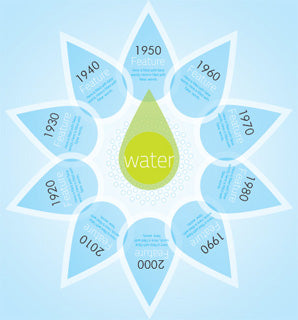|
The process known as osmosis has been happening in nature for millions of years and it occurs in our bodies every day. From a scientific standpoint, it was first discovered back in 1748 by Jean-Antoine Nollet, a French clergyman and physicist. Nollet was able to replicate the osmotic process by using a pig’s bladder as a membrane to show that solvent molecules from low solute water could flow through the bladder wall into a higher solute concentration made of alcohol. He proved that a solvent could pass selectively through a semi-permeable membrane through the process of natural osmotic pressure and the solvent will continually enter through the cell membrane until dynamic equilibrium is reached on both sides of the bladder.
 The study of osmosis would all but disappear for the next 200 years until the late 1940s when researchers from top American universities began to reconsider the topic. This renewed interest was based on a desire to find a way to filter or desalinate sea water, which was a goal set by the Kennedy administration to help develop water shortage solutions for the country. In 1959, two researchers at UCLA, Sidney Loeb, and Srinivasa Sourirajan succeeded in producing a functional synthetic RO membrane from cellulose acetate polymer. In their tests, a body of high solute water was pressure forced through the engineered membrane which acted as a filter that allowed only water molecules to pass through while rejecting NaCl (salt) and TDS. Fresh water was able to pass through at a decent flow rate to produce purified, drinkable water and the membrane was actually durable and could operate under normal water pressure and operating conditions. Since this new technology worked in reverse of the natural osmotic process, it soon became known as reverse osmosis.
The study of osmosis would all but disappear for the next 200 years until the late 1940s when researchers from top American universities began to reconsider the topic. This renewed interest was based on a desire to find a way to filter or desalinate sea water, which was a goal set by the Kennedy administration to help develop water shortage solutions for the country. In 1959, two researchers at UCLA, Sidney Loeb, and Srinivasa Sourirajan succeeded in producing a functional synthetic RO membrane from cellulose acetate polymer. In their tests, a body of high solute water was pressure forced through the engineered membrane which acted as a filter that allowed only water molecules to pass through while rejecting NaCl (salt) and TDS. Fresh water was able to pass through at a decent flow rate to produce purified, drinkable water and the membrane was actually durable and could operate under normal water pressure and operating conditions. Since this new technology worked in reverse of the natural osmotic process, it soon became known as reverse osmosis.
The world’s first commercial RO plant was built in Coalinga, California with the help and direction of Joseph W. McCutchan and Sidney Loeb and in 1965 its pilot program drew the attention of engineers and governments from around the world. This incredible dream, that one day humanity could actually desalinate sea water on a large scale and affordably, was finally coming true. Progress grew quickly as new pilot programs sprung up elsewhere like La Jolla and Firebaugh California to test different types of brackish and seawater. The innovations and discoveries of these and many other contributors would make membrane technology relevant and affordable and provide clean water benefits for many heavy industries.
Today, reverse osmosis and membrane filtration elements are used for thousands of different processes and applications around the world, and this industry is expected to continue to grow unabated into the near future. With natural clean water sources becoming more scarce and the continual trend of world desertification, large reverse osmosis processing plants now provide much of the clean water used by some cities and even small countries. Most people don’t realize it now, but in the near future clean water may soon become one of the most valuable resources on the planet which is why RO technology is indeed one of the top scientific achievements in human history.



